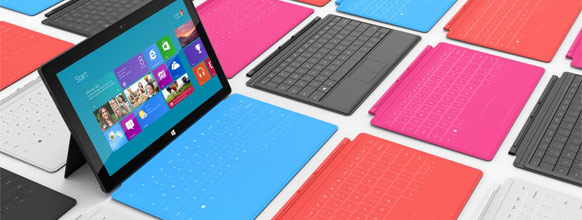As this tablet is to hit the market before other Win8 tablets are launched by the OEM licensees, it would suggest that Microsoft aims to showcase the full capabilities and benefits of Win8 on a tablet device (available as both ARM-based and Intel x86 processor technology versions) and has therefore decided to take responsibility for the hardware.
June 19, 2012

By Dave McQueen
Microsoft unveils Surface, its own-brand tablet based on Windows 8 with the touchscreen-friendly Metro user interface.
As this tablet is to hit the market before other Win8 tablets are launched by the OEM licensees, it would suggest that Microsoft aims to showcase the full capabilities and benefits of Win8 on a tablet device (available as both ARM-based and Intel x86 processor technology versions) and has therefore decided to take responsibility for the hardware. This will put it in direct competition with other OEMs wishing to launch Win8 tablets, but is similar in some ways to when Google launched its own-brand Nexus smartphones to showcase the benefits of Android, albeit that the software was “free”. By taking this approach, Microsoft needs to make sure it hits the market running as it is essential the tablet is properly marketed and shows its full potential if it has any hope of displacing Apple’s iPad in certain segments.
In terms of market potential, if Microsoft can convince consumers, enterprise and OEM partners alike of its value proposition then it should do well. Specific pricing was not mentioned in the release (although the ARM-based tablet will be cheaper than the Intel version) but this will be vital to market acceptance as will screen size, memory and applications – all of these are important points of differentiation in the tablet space. Surprisingly, the Surface will be larger and heavier than the iPad with a 10.6 inch display, which may not differentiate it enough from the Apple product. However, Microsoft has included a built-in kickstand, Touch Cover peripheral for keyboard and trackpad, magnesium casing and a pen accessory to create points of differentiation, although some of these have up until now had varying levels of success in the tablet market. Of these, the Touch Cover could prove successful as the keyboard and trackpad feature is missing from Apple’s smart cover.
Tablets have been finding their way into the enterprise, despite being mainly classed as consumption rather than productivity devices, and it will be interesting to see if a Microsoft tablet changes that perception. If it has the requisite Windows office applications available from launch – across both device types and suitable peripherals to make input easier – at a price point that is competitive, then I do see it displacing notebooks and netbooks in the office. However, there may be a problem with fragmentation owing to ARM-based and Intel-based versions of the same Win8 tablets, and possible differences once other vendors launch products, which may stymie the market in a way that has caused Android to suffer to some extent. However, this may be addressed in future Windows releases that pull together full support for the enterprise and are also optimized for touch and gesture control.
Read more about:
DiscussionYou May Also Like






.png?width=300&auto=webp&quality=80&disable=upscale)


_1.jpg?width=300&auto=webp&quality=80&disable=upscale)


.png?width=800&auto=webp&quality=80&disable=upscale)